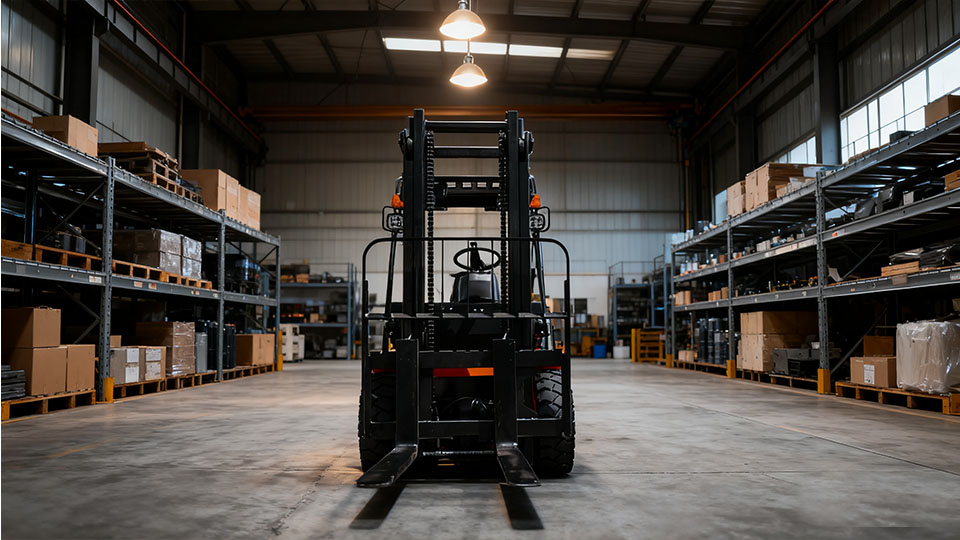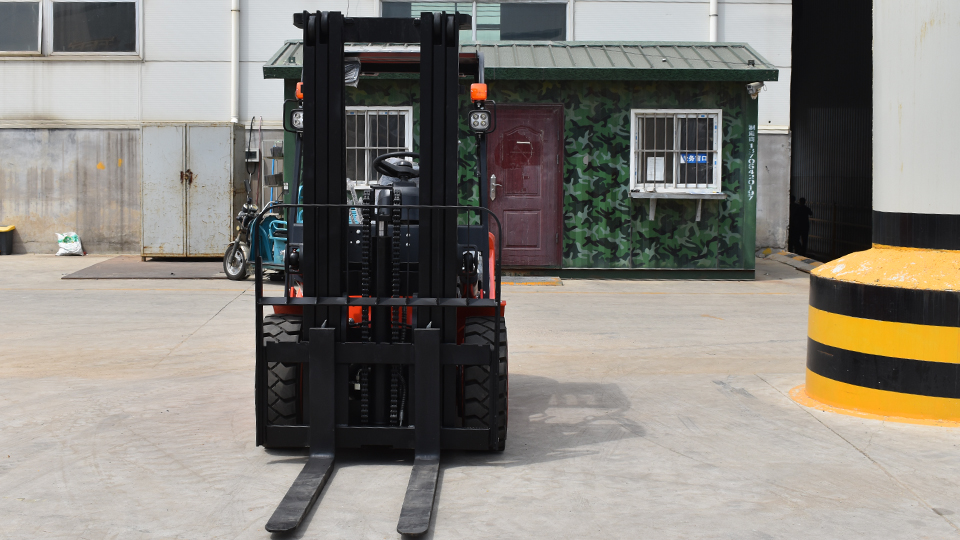
0. Executive summary
"Service weight" (a.k.a. tare, curb, operating weight) is the mass of the ready-to-work truck including battery, fuel, oils, coolants, standard mast, forks and operator. It is not the same as rated capacity, fork weight or shipping weight. For 2025 production models the envelope spans 1 050 kg for a 1.5 t electric pallet stacker to 62 000 kg for a 45 t reach stacker. Service weight dictates transport permits, floor loading, container stuffing, trailer decks, dock-board rating, stability triangles and tire selection. This article explains how OEMs arrive at the number, where hidden 150 kg options creep in, and how to predict the weight of a truck you have not yet received.
1. Definition maze – which "weight" is which?
Term Scope Typical variance from service weight Standard
Shipping weight Bare mast removed, battery excluded, 5 % fuel −8...−20 % ISO 22915-1
Fork weight Only the fork carriage + forks −8...−12 % ISO 2330
Rated capacity Payload the truck can lift (not weigh) +100...4 000 % ISO 3691-1
Service weight Full fluids, std battery/fuel, 75 kg operator, std mast & forks 0 % (reference) ISO 3691-1 §3.28
Throughout this paper "weight" is used colloquially; the physical quantity is mass in kilograms.
2. Why service weight matters
Floor design: 3 000 kg truck + 5 000 kg load = 8 t point load; slab thickness grows with the fourth root of load.
Elevator decks: ISO 3691-5 requires that truck weight be ≤ 25 % of elevator rated load.
Containerisation: 40 ft HQ max gross 30 480 kg; a 12 t service weight eats 39 % of the allowance.

Road permits: EU modular concept allows 40 t GVW, but axle load ≤ 10 t; a 12 t empty lift needs 4-axle low-loader.
Tire heat: hysteresis ∝ weight³; a 10 % mass reduction extends tyre life 30 %.
Stability: tip-over axis is proportional to service weight × load centre; every +100 kg on counterweight can shift rated capacity +80 kg.
3. OEM weighing protocol (2025 procedure)
Truck conditioned: 15–25 °C, tyres at nominal pressure, oils to upper dipstick mark, 100 % fuel or battery SOC.
Standard equipment: mast, forks, side-shift, cabin if ordered by catalogue as "base".
Operator simulated: 75 kg steel weights on seat.
Scale: ±0.5 % accuracy, individual axle then total.
Result rounded to nearest 10 kg (50 kg above 20 t).
Value engraved on nameplate and encoded in VDI 2198 telematics frame.
4. Physics model – predict weight before you buy
Service weight ≈ k × (rated_capacity)^0.75
where k = 600–700 for electric cushion, 750–850 for diesel pneumatic, 900–1 100 for rough-terrain telehandler.
Exponents < 1 because counterweight mass scales slower than payload thanks to longer wheelbase and larger tyres.
Example: 5 t diesel pneumatic, k = 800 → 800 × 5^0.75 ≈ 2 680 kg (actual Hangcha CPCD50-NG2: 2 720 kg; error 1.5 %).
5. Weight distribution – where the kilograms hide
Typical 2.5 t electric (3-wheel) 4 100 kg service weight:
Frame & counterweight 1 800 kg (44 %)
Traction motor 120 kg (3 %)
Li-ion battery 80 V 460 Ah 1 250 kg (30 %)
Mast + carriage 520 kg (13 %)
Wheels & axles 180 kg (4 %)
Cabin, heater, on-board charger 150 kg (4 %)
Fluids & operator 80 kg (2 %)
Add 200 kg for lead-acid battery of same capacity, or 90 kg for heated cabin.
6. 2025 production service-weight cheat-sheet
Data extracted from EU type-approval sheets Sept 2025.
Class Model Rated t Service kg Power Notes
III EP CPD15L2 Li 1.5 1 050 24 V 40 Ah Entry pallet stacker
III Noblelift PS 20 2.0 1 320 48 V 105 Ah Walkie straddle
I Toyota 8FBE20 2.0 4 100 80 V Li-ion 3-wheel
V Heli CPCD25-NG2 2.5 3 680 2.4 L diesel Pneumatic
V LYMG CPCD35 3.5 4 750 3.8 L diesel
V Hangcha CPCD50-NG2 5.0 7 220 3.8 L diesel
V Toyota 8FG60U 6.0 8 950 3.0 L LPG
V Hyster H8.0FT 8.0 11 300 4.5 L diesel
VII Manitou MLT 960 ST 6.0 11 800 3.8 L diesel Telehandler
VII XC6-4517K 4.5 17 200 4.5 L diesel RT forklift
VIII Kalmar DRF450-60S5 45 t 62 000 13 L diesel Reach stacker
7. Effect of popular options (kg)
Sideshift carriage +90
Hydraulic fork positioner +120
3rd & 4th valve +25 each
Full cab HVAC +180
Solid tyres vs pneumatic +70 (std set)
Lead-acid instead of Li-ion +250 on 2.5 t truck
Larger battery 620 Ah vs 460 Ah +190
Fire suppression system +40
Extra counterweight kit +300 (bolted)
A 2.5 t electric can therefore grow from 4 100 kg → 4 930 kg (+20 %) once all comfort options are ticked.

8. Shipping vs service – real case
Truck: 3.5 t diesel, service 4 750 kg
Mast removed: −520 kg
Fuel drained (70 L): −60 kg
Battery (12 V 100 Ah): −28 kg
Operator ballast: −75 kg
Net shipping: 4 067 kg
Freight forwarder must still allow 4.2 t because forks and mast travel in the same 40 ft container.
9. Floor loading example
Warehouse slab rated 5 kN m⁻² = 510 kg m⁻².
Truck 4 100 kg on footprint 2.1 m × 1.2 m (jack legs) = 1 627 kg m⁻² → 3.2× overload.
Solution: add 12 mm steel plate 2.5 m × 1.5 m → contact area 3.75 m² → 1 093 kg m⁻² (still unsafe).
Correct engineering: specify 8 kN m² (815 kg m²) slab with fibre reinforcement and 150 mm thickness.
10. Container stuffing matrix
40 ft HQ internal payload 28 300 kg after tare.
Truck t Service kg Qty per box Left for lashings
2.0 3 680 7 2 540 kg
3.5 4 750 5 4 550 kg
5.0 7 220 3 6 640 kg
8.0 11 300 2 5 700 kg
Anything > 12 t requires RORO or flat-rack.
11. Regulatory name-plate requirements
ISO 3691-1:2022 clause 6.2 mandates:
Service weight (kg)
Rated capacity (kg)
Load centre (mm)
Tyre specification & pressure
Battery voltage/cap or fuel type
CE mark added 2025: QR code linking to EU type-approval certificate.
12. How to audit a forklift you already own
Park on level concrete, mast vertical, forks 300 mm ground.
Calibrated axle scales ±0.2 % (e.g., Intercomp SW-550).
Record front axle, rear axle, total.
Add 75 kg if operator absent.
Compare to nameplate; deviation > ±2 % indicates unrecorded options or missing counterweight bolts—inspect immediately.
13. Future trends (2026–2028)
LFP batteries: 15 % lighter than lead-acid of same kWh → −200 kg on 2.5 t truck.
SiC inverters: 8 kg savings on copper busbars.
Composite counterweights: basalt fibre + concrete −8 % weight for same moment.
Modular ballast: bolt-on 50 kg slices ordered online, RFID tagged for automatic capacity recalculation.
Augmented-reality weighing: phone camera recognises truck, overlays service weight from cloud database ±10 kg accuracy.
14. Practical checklist for purchasers
Always ask for the optioned service weight, not the brochure minimum.
Include 5 % fuel or 100 % battery in RFQ; otherwise shipping weight will be quoted.
Specify floor loading early; upgrading a 200 mm slab to 250 mm after pour costs 3× more than designing correctly.
When replacing lead-acid with Li-ion, subtract weight difference from counterweight to keep axle loads neutral—otherwise stability curve changes.
Record weight in fleet database; use it to calculate trailer permits, elevator audits, tire procurement and CO₂ footprint (kg t⁻¹ km⁻¹).
15. Conclusion
Service weight is the single most important yet most underestimated number in forklift specification. It ranges four orders of magnitude—from 1 t walkies to 60 t reach stackers—and can swell 20 % once real-world options are added. Understanding how OEMs measure it, how regulators police it, and how it interacts with floors, elevators, trailers and stability gives buyers negotiating power and eliminates expensive surprises after the truck is on the ramp. Treat the kilograms as seriously as the lift height and you will never again ask, "But why is the forklift too heavy for my elevator?"
Name: selena
Mobile:+86-13176910558
Tel:+86-0535-2090977
Whatsapp:8613181602336
Email:vip@mingyuforklift.com
Add:Xiaqiu Town, Laizhou, Yantai City, Shandong Province, China